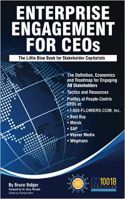 Contrary to popular belief, the concept of stakeholder management goes back at least to the 1950s and probably earlier to a small group of business leaders and academics who recognized that there is no way to optimize returns for shareholders over time without addressing the interests of their customers, employees, supply chain and distribution partners, and communities. This internal benchmarking survey is designed to help you quickly find out if your organization is already on its way to benefiting from a business approach that seeks to enhance sustainable returns for investors only by creating value for stakeholders and the environment.
Contrary to popular belief, the concept of stakeholder management goes back at least to the 1950s and probably earlier to a small group of business leaders and academics who recognized that there is no way to optimize returns for shareholders over time without addressing the interests of their customers, employees, supply chain and distribution partners, and communities. This internal benchmarking survey is designed to help you quickly find out if your organization is already on its way to benefiting from a business approach that seeks to enhance sustainable returns for investors only by creating value for stakeholders and the environment.| Principles | Explanation | Yes/No |
|
1. A clear leadership vision that creates a North star. |
· Your organization’s leadership is focused on enhancing returns for investors only by creating value for customers, employees, supply chain and distribution partners, communities, and the environment. · Your annual business plan is focused on achieving the purpose, goals, and objectives of the organization by welcoming and engaging the broadest possible audience of customers, employees, supply chain and distribution partners, and communities, without offloading employee, environmental, or other costs or risks on to society. |
|
|
2. A business operating system to ensure consistent management. |
· Your organization has a system in place to strategically manage the organization’s business plan across the year in a manner that aligns the interests of all stakeholders through carefully coordinated processes to maintain consistency of all engagement practices, including recruitment, communications, learning, stakeholder voice, rewards and recognition, DEI (diversity, equity and inclusion) across the organization. |
|
|
3. Customers: A strategic focus on delivering marketing promises. |
· Your organization has a clear value proposition and specified product and service standards for its customers, distribution, and supply chain partners that it rigorously monitors using a systematic listening process through which it seeks to continuously improve. · You look for new customers from the broadest possible sources to maximize market reach and have a clear strategy to engage them. · You transparently convey your pricing, terms, and conditions to minimize surprises and confusion. · You use clear metrics such as customer loyalty; referrals; engagement scores; revenues, costs, and profits per customer to manage a continuous improvement process. |
|
|
4. Employees: Managed as an asset instead of a sunk cost. |
· Your organization bakes its purpose, goals, objectives, and values into all employee management activities and has a system for singling out leaders and others at any level whose behavior contradicts its principles. · Your organization has a strategic and systematic process for attracting and developing talent from the broadest possible sources to benefit from the widest possible choice of potential. · All full-time employees earn at least a minimum wage with the benefits necessary to live without the need for government aid and can clearly share in the organization’s success over time; independent contractors benefit from transparent pay and terms. · Serious consideration is given to the design of jobs and the employee experience and engagement and development process, including a career development roadmap when appropriate and regular check-ins from management to make sure employees are okay. · There is a systematic approach to listening to employees and using their suggestions. · You have clear metrics to monitor the impact of employee management practices on business results, including: revenues, costs, and profits per employee; referrals; loyalty; wellness, safety, and health; diversity, as well as human capital value add and human capital ROI. |
|
|
5. Supply chain and distribution partners: partners in success. |
· Your organization views your suppliers and distribution partners as critical to success, with transparent policies for selecting and developing effective relationships. · Your organization reaches out to the broadest possible selection of suppliers and distribution partners to maximize your impact in the largest possible marketplace. · You have a systematic approach to communicating with and developing effective relationships through training and a formal listening process. · There is a clear system for measuring the effectiveness of supply chain and distribution management based on the metrics most relevant to the organization and its industry and there is a system in place for continuous improvement. |
|
|
6. Communities: Strategic philanthropy aligned with organizational goals. |
Your organization strategically directs philanthropy to activities that support its own stated purpose, goals, and objectives. For instance: · Your organization has a long-term “farm team” strategy for developing talent, customers, distribution, and supply chain partners, from the communities in which it operates. These could include training programs at schools in disadvantaged areas that develop skills the company can benefit from later on; looking for ways to successfully recruit and develop neuro-divergent or others who are disadvantaged, seniors, disabled, homeless, ex-convicts, people in alcohol and/or drug recovery, etc. · Your organization strategically supports community activities that provide it with important marketing visibility with targeted audiences. · Any charitable contribution to any political or social cause outside of the organization’s stated goals and objectives is disclosed and explained. · Your company takes advantage of all reasonable advantages in the tax code without abusing dubious loopholes that make it so that its taxes are far below the intent of the law. · The company’s strategic philanthropy metrics are tied to broader organizational goals such as talent, customer, distribution, and supply chain partners, and not to the undisclosed interests of the organization’s management. · Your organization stays out of politics unless an issue is core to its stated purpose, goals, and objectives. |
|
|
7. The environment: A commitment to Milton Friedman’s stated dictum to not impose hidden costs on society. |
· Your organization does everything in its power to continuously and transparently, improve its Scope 1, 2 and 3 emissions, re-use, and recycling practices in a manner that, whenever possible, improves productivity and quality or provides other organizational benefits, such as customer or community good will. · Your organization makes every effort to design its facilities consistent with the communities in which it operates and ro leave nothing behind if it departs. Clear metrics are published, along with a transparent continuous improvement process. |
 ESM News Alert for the latest news. Subscribe here.
ESM News Alert for the latest news. Subscribe here.
